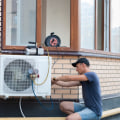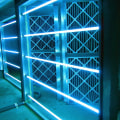The Ultimate Handbook on How to Measure HVAC Furnace Air Filter Size
Ready to measure your HVAC furnace air filter size? First, remove your existing filter, but be careful - it can be quite messy. Now, grab your ruler to take three measurements: height, width, and thickness. You might even find these dimensions on the filter frame itself.
Establishing the perfect fit for your filter is vital. This prompts peak HVAC system operation, decreases relevant energy costs, and advances indoor air quality. Better to note, that if you select a filter that is a little too small, your furnace parts will stay exposed, and a kind that is too big won’t oblige.
With your measurement immediately available, you’ll be ready to check out various types of air filters. Some filters align with your HVAC system more than others, relying on the material, and efficiency rating on factors that impact the choice you make.
Main Points to Remember
For size referencing, carefully remove your existing HVAC furnace air filter.
Employ a ruler for precise measurement of the filter's length, width, and thickness.
Observing quick filter degradation can suggest incorrect filter sizing.
Correctly sized filters enhance the performance of your HVAC system and purify indoor air.
Dispose responsibly of the worn-out air filter to keep your HVAC system healthy.
Understanding HVAC Furnace Air Filters
The function and specifications of furnace air filters are important for effective HVAC system maintenance. Far from being simple devices, these components serve as your foremost shield against airborne pollutants infiltrating your living space. Imagine them as diligent sentinels, barring unwanted particles while facilitating the circulation of clean air.
Each filter material offers unique benefits and drawbacks. For example, fiberglass filters appeal to cost-conscious consumers due to their affordability and disposability, yet their particle-trapping capabilities are somewhat limited. In contrast, pleated filters boast superior efficiency owing to their expanded surface area. Then, there are washable filters, which offer long-term cost savings as they can be cleaned and reused.
Efficiency ratings of these filters, often expressed in MERV numbers, are another vital aspect to consider. These ratings extend from 1 to 16, with ascending values representing enhanced efficiency. Still, higher numbers shouldn't be the sole determinant. Ideal efficiency is a function of your specific HVAC setup and the quality of air within your living space.
Importance of Correct Filter Sizing
Picking the accurate size for your furnace air filter matters significantly. It's not merely small but vital for preserving your HVAC system's functionality and productivity. Cutting filters in the wrong sizes can reduce efficiency, which might lead to high energy costs and potential damage to your HVAC system. Small-sized filters will not cover the intake area entirely, allowing unfiltered air into your system. With time, more dirt and debris will accumulate in your furnace, which would require your furnace to work an extra mile. Large-sized filters will not fit in the provided space, leaving little room for unfiltered air to get to your system.
The impacts of incorrect filter sizing extend beyond system efficiency, touching upon health as well. Properly sized filters play an important role in removing pollutants and allergens from the air, enhancing indoor air quality. However, ill-fitting filters might let harmful particles escape filtration and circulate in your living space. Such a situation could worsen allergies and respiratory issues, affecting your home's health and comfort levels.
Identifying Your Current Filter Size
To replace your furnace air filter, first, pinpoint its size. Inspect the filter's frame closely - often, you'll find the size printed there, typically in inches. For example, '20x25x1' would suggest that your filter is 20 inches long, 25 inches wide, and 1 inch thick.
Why does size matter? A filter's lifespan relies heavily on its size. Larger filters, with more surface area, can trap more dust and particles, and as a result, tend to last longer than smaller ones. Correctly sized filters heighten your HVAC system's efficiency and can even lengthen its lifespan.
In contrast, undersized filters leave parts of the duct exposed, allowing debris to escape and potentially damage your system. Oversized filters simply won't fit. Therefore, accurate knowledge of your filter size is important.
When replacement time comes, consider the proper methods for disposal. Some filters are reusable and need only a good cleaning, while others will need to be disposed of safely. Consult with your local waste management for relevant guidelines. Maintaining a clean filter is the secret to an efficient furnace.
Steps to Measure Your Filter
The size of your filter is important for efficient HVAC operation. Start by carefully removing the current filter from the HVAC system, keeping it for reference.
Arm yourself with a ruler or tape measure, plus a notepad to record your measurements. Begin by determining the filter's length, moving on to its width, and concluding with the thickness. All measurements should be in inches, as HVAC filters usually follow this standard.
A correctly sized filter not only extends its lifespan but also boosts the HVAC system's performance by trapping allergens and dust particles more effectively.
Should your filter seem to wear out rapidly, its size could be the issue. Reflect on the dimensions you've recorded, comparing them to the size indicated on the filter packaging. Discrepancies between these measurements indicate the need for a replacement.
Patience is vital here. Therefore, knowing how to accurately measure your HVAC furnace air filter size will contribute to the longevity of your HVAC system and ensure cleaner indoor air.
Tips for Choosing the Right Filter
Selecting an appropriate filter for your HVAC system requires considering aspects like material composition, MERV score, plus specific indoor air quality requirements.
Materials used in filters significantly influence their longevity and efficiency. Budget-friendly fiberglass filters have short lifespans. In contrast, pleated filters, despite their higher cost, catch more pollutants and endure longer. For those with allergies or pets, high efficiency HEPA filters are worth considering.
MERV ratings, indicative of efficiency, play a key role. These ratings span from 1 to 20. Filters with higher MERV scores offer superior filtration, yet can impede airflow, putting pressure on your HVAC system. Therefore, balance is essential. For average households, MERV ratings between 8 and 13 are typically adequate.
Factor in indoor air quality requirements too. For allergy sufferers or those with respiratory problems, filters with higher MERV scores might be necessary. Pet owners should look for filters adept at trapping pet dander.
Selecting a suitable filter involves more than just size. Comprehension of materials, efficiency scores, and specific requirements is also vital.
Frequently Asked Questions
What's the Lifespan of a Typical HVAC Furnace Air Filter?
Filter longevity tends to vary. Some may need replacement every 1-3 months, based on their kind. Regular checks on your filter ensure timely replacements, maintaining efficiency.
How Do Weather Conditions Affect the Performance of My Filter?
Efficiency of your filter is highly influenced by weather conditions. Performance might be hampered by seasonal changes such as extreme cold or elevated humidity levels. Regular monitoring and timely replacement of filters are needed for consistent performance in diverse climates.
Can I Use a Washable Filter Instead of a Disposable One?
Certainly, opting for washable filters is feasible. Such filters boast cost-effectiveness, along with being eco-friendly. Important to remember, however, is the diligent upkeep of these filters for maintaining the HVAC system's efficiency and extending its service life.
What Are the Potential Problems Caused by an Incorrectly Sized Filter?
A filter that doesn't fit correctly can spell disaster. Misalignment may ensue, causing your device's performance to drop. Correct sizing is essential to prevent unneeded expenses and upkeep complications.
How Does the Filters MERV Rating Impact the Air Quality in My Home?
Air quality within your residence gets directly influenced by the MERV rating of your filter. Increased MERV ratings correlate with improved reduction of allergens. Comprehending this rating remains essential for maintaining healthy air in your living space.
Here is the nearest branch location serving the Palm City area…
Filterbuy HVAC Solutions - West Palm Beach FL
1655 Palm Beach Lakes Blvd ste 1005, West Palm Beach, FL 33401
(561) 448-3760
https://maps.app.goo.gl/xyqVoYNrXPyjRwVy6
Here are driving directions to the nearest branch location serving Palm City…



